Dear VW-friends,
excuse me for choosing a headline in German, let me try to explain. When East Berlin citizens stormed the Berlin Wall November 9th 1989, Willy Brandt (Germany´s chancellor from 1969 until 1974, but more important Berlin´s mayor when the East Berlin villains erected the Berlin wall in 1961) immediately rushed to Berlin and declared in front of the crowd in this total chaotic situation in which nobody knew what would happen next, this certain phrase everybody knows in Germany today. It means “now grows together what belongs together”.
Willy was quite upset when the East Berlin regime erected the wall and he never gave up dreaming that “his” Berlin would be reunited someday. This certain night in 1989, when Willy was already an old man, having just three more years to live, he knew that his dream would come true now, even though hardly anybody was sharing his believe the previous 28 years.
When Mark visited me for the first time, just a few days after we dug out the Samba in the Eifel, and I asked him “Is it possible to restore?” he kneaded his chin, considered, and said: “I think it´s possible.” Hardly anybody beside the two of us would have believed in this possibility. Today, when checking out the new pictures, you will agree: now grows together what belongs together.
We are facing a new stage in the restoration today. After the chassis, the engine, the gearbox, the brakes and many other components including a lot of the body parts are rebuilt by now, we are assembling the puzzle in a final way. At first glance, you might not see a big difference between the situation the Samba was shown in Bad Camberg 2019 and now, but opposite to back then, when we just welded some pieces on a provisional subframe, we are now talking about the final assembly
Mark expresses it the following way: “Ok so were at welding together stage, the bus is pulled to the frame which is sat at the right measurements. Cab is mostly welded at the front and floor, front panel is still held on with screws but after a few little adjustments it can go on.”
Before we get into the big body progress let´s have a look on a nice detail. This is part of a picture Mark send me yesterday:
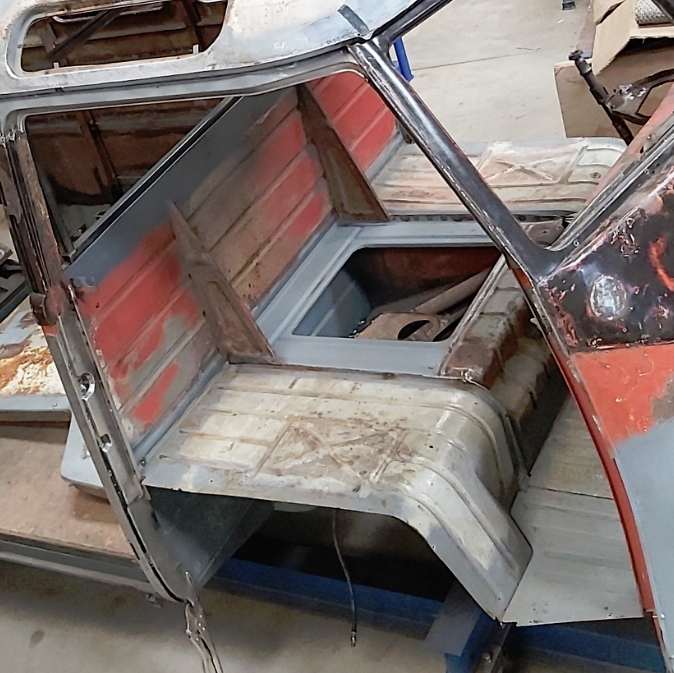
It took me quite some time to realize it. It´s about the sealing wax color of the bulkhead. I didn´t remember the bulkhead to show original color, so I dug out an older picture to check:

You see the upper and the lower part of the upright bulkhead panel in primer, because Mark welded here. The section in between was still intact, but showing the very same silver-beige color the entire Bus showed when it was found back in May 2017. This means, that this very last respray in the Samba´s first life was done very surprisingly laborious, whoever did the job even removed the seats to paint this section, but left the dashboard sealing wax red. Strange, isn´t it?
Anyway, I asked Mark if he painted this section red, but he replied: “That’s lovely original paint; I found it under this weird silver paint. It was not easy to remove and the job is not finished but it will be soon enough.” I LOVE his style of working! This is just the way I want this Bus to be reconstructed: save as much as possible of the original substance, even all those bits that you can´t see at first glance and even all that you wouldn´t believe is still in existence!
But now it´s time to get into the body work. Remember the posts “Roof and roots” ? It was all about the “most repaired roof in the world” (Mark´s words…) and indeed this masterpiece here shouldn´t be called anything less than that:

But before welding the entire roof to the bus, the roof gutter has to be reconstructed. As far as I remember, there was nothing left of the original gutter, so Mark had to reconstruct this entirely. He wrote to me: “A pic of the roof gutter being spot welded down. This involved a ton of measuring and finishing of the rear Posts too, the levelling was a lot of work to get the rail exactly the same height from the ground as we had put a lot of work into getting the roof flat so needed the gutters and posts to all sit correctly before we joined it all up. The sides were then clamped flat so they sit really nice and straight when you look down the sides by the roof line. Wiring tabs for the semaphore and the main loom were added in the right spot too as it’s hard to do with the roof on.”
So, here is the spot welding:
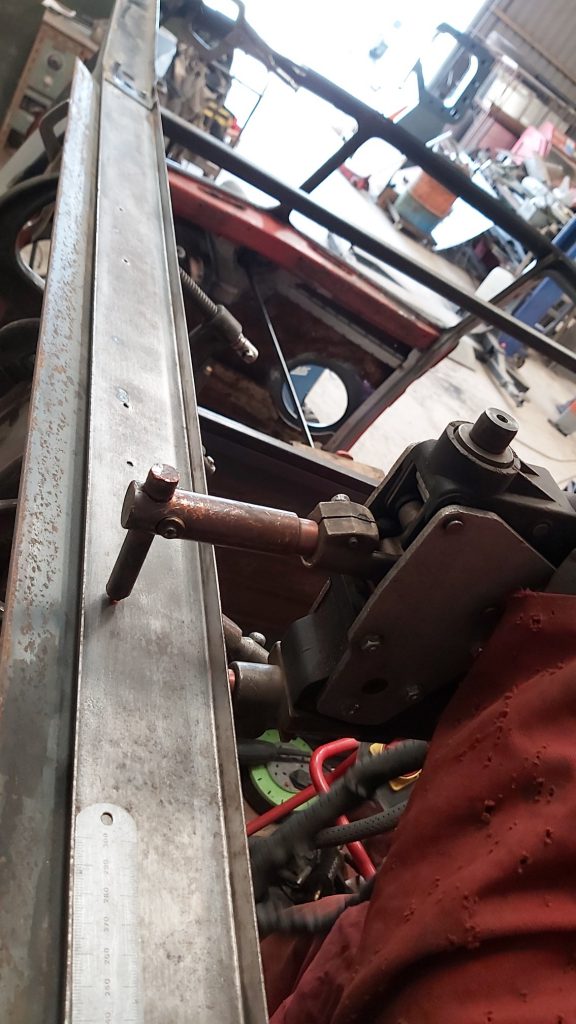
And here we go for the complete gutter:
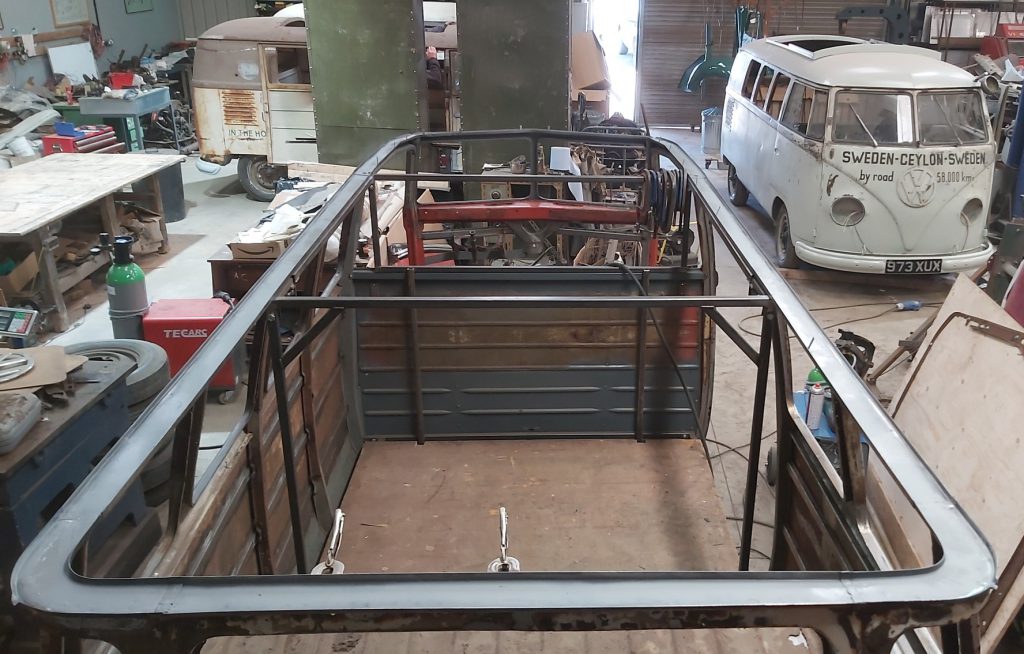
Seeing this picture makes it easy to understand why nothing of the original gutter survived: it was the perfect water drainage once the roof had the first rust hole to let the water in. While the roof itself had the chance to dry in the sun after the rain, the gutter stayed moist and rotted fast!
Now the roof is ready for installation, right? Well, bodywise it is, and an average body shop would now weld the roof on. Luckily, Mark isn´t just an average body welder, but a VW-enthusiast inside out and so he knows that the super early Barndoors didn´t have the wiring loom located in the chassis rail, but in the roof gutter! If you would weld the roof on the gutter now, the poor electricity guy would have a really hard time to get the loom in place later, so you better put in the loom now!
Sure, the gutter needs a hole where the loom can drain towards the engine bay and Mark has seen enough early Barndoors to know where this hole is supposed to be: exactly above the front corner of the engine bay. But, wait a minute, when it comes to a Samba, this certain spot is also the location of the additional side window, which means that the loom would, after passing the gutter´s hole, have to turn towards the front again to reach the post between the side windows to keep on draining further down on its way towards the engine bay.
This way would be much longer than the way in a regular bus and so this way would have required a Samba-specific loom, in fact a longer one. We both doubt that the factory was in the mood for a Samba-specific loom, especially not in the early days when the whole Samba production was kind of prototyping. So, if there was no Samba-specific loom, the Samba must have had the hole in the gutter located a little more towards the front, just exactly above the post between the side windows (the circled spot in the following picture):
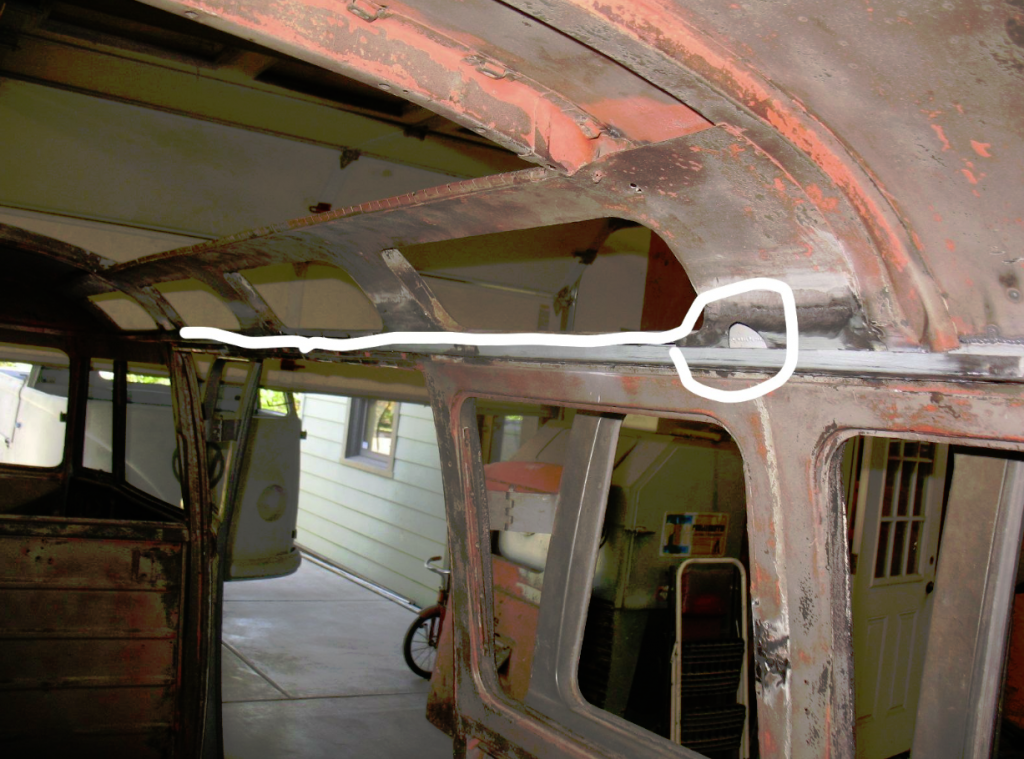
Since the factory changed the location of the loom as early as February 11th 1952 at VIN # 20 – 021 555, it was my turn to find a Samba born before this February ´52 to proof the theory. Well, there are not too many super early Sambas, but luckily I had access to one survivor to check. And, lucky again, the headliner of the survivor was friendly enough to show a little gap in the headliner just at the spot where (following our theory) the hole must be in the gutter to drain the loom into the post between the side windows. See here:
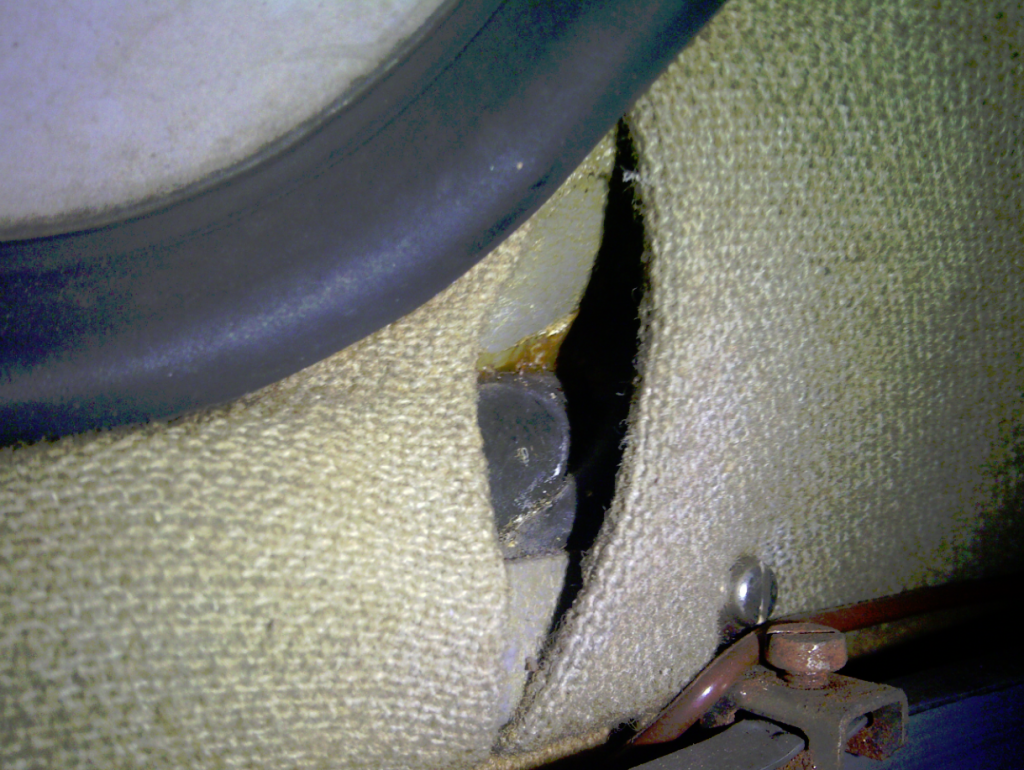

Quod erat demonstrandum!
The Samba loom passes in fact through a Samba-specific hole in the gutter and doesn´t have a Samba-specific longer loom! Another Barndoor secret revealed. Isn´t our nerdy hobby the greatest waste of time you can imagine?
Let´s keep on checking out what other parts of the puzzle Mark has finished. Remember the post “A beautiful rear end is always worth a closer look….” about the engine compartment? This was the situation last December:
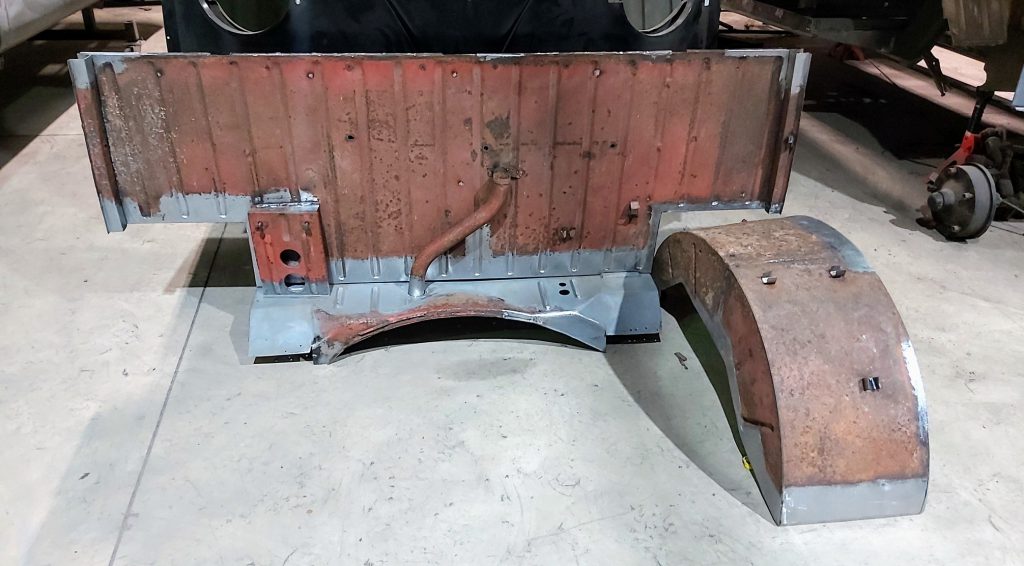
Great work, no doubt, but the left wheel arch was missing on the picture. In fact Mark made an entire new one, because there was not too much left of the original, but this didn´t satisfy him. He wrote:“Here is the other rear wheel arch, now saved like the other one. We had a new one we made in the older pics but used that to repair this original.” Here is the result:
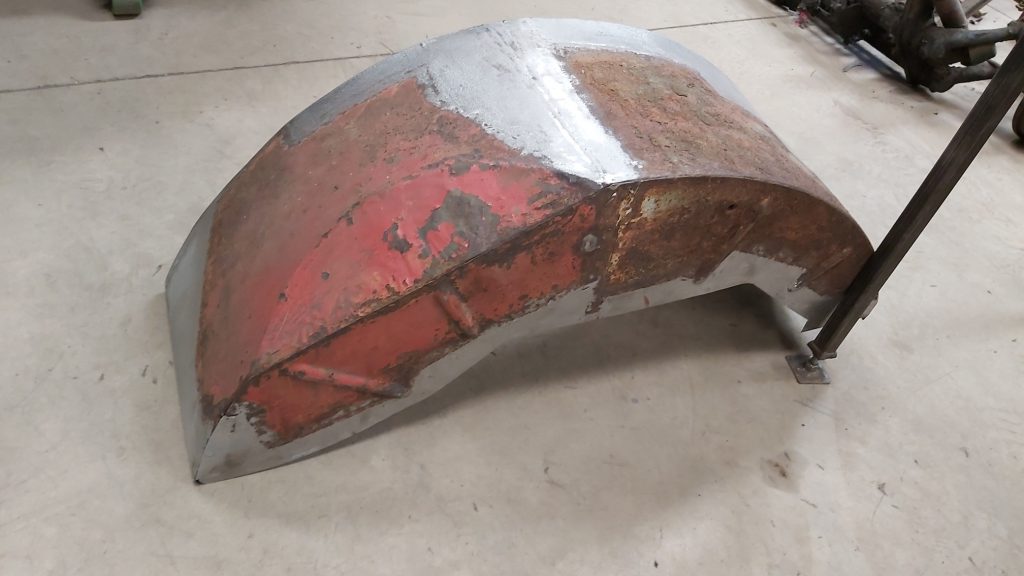
Great job, isn´t it? Especially the original sealing wax paint kicks ass again, don´t you think so? But not only the roof and the rear of the Samba made big progress in 2021 so far, also the front is on the road to the finish line now! See here the right B-post, a really tricky section, believe me. When I tried to install the semaphores for the show season 2019, I realized how poor and bent it was and I thought to myself: “This is going to be a hell of a job if Mark wants to save what´s left of the B-post….”
Now have a look at how accurate the B-post is by now! The patina sealing wax paint ensures again that this is the real original post, no ordinary reproduction! Mark wrote: “Here is the B-post, as you can see a fair chuck got saved.”
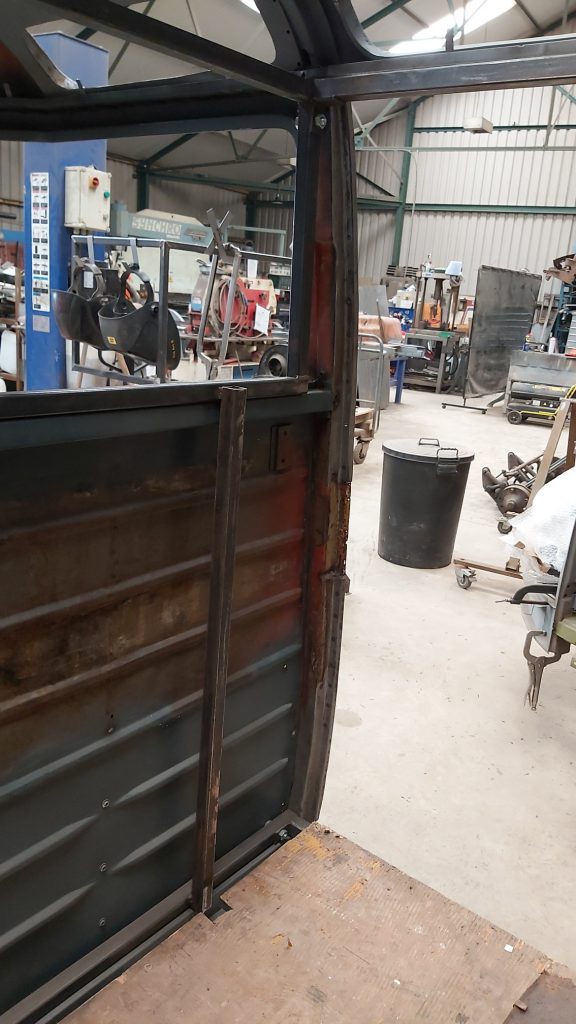
Further to the front, there is also more progress. In Mark´s words: “The front dash and the steering column mount are all welded too, as is the screen surrounds etc. Moving away from screws to measured correct gaps is a big step onwards too, the whole bus now is solid already with the cab being welded up.”
An exiting picture, especially the original paint made my day again. When the Samba was found, the front was torn into pieces, the only useable surviving elements seemed to be the original windshields (stuck in the mud in front of the Bus!) and the two poor pieces of the Samba-dash. The front apron laid way beside the Bus and was in very, very rotten condition, same was the front of the roof. Nobody but Mark was even thinking about the possibility to save it. Now look how nice everything fits together with the NOS windshield frame I was lucky enough to find and Mark´s fine A-post creations:
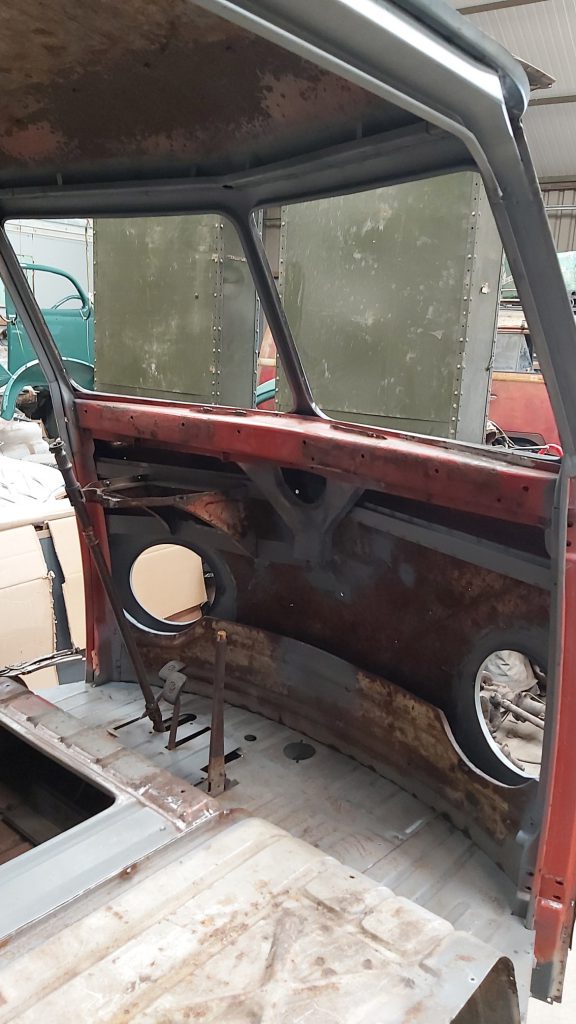
How the entire puzzle does look like currently? Enjoy the following pictures made from three different ankles:
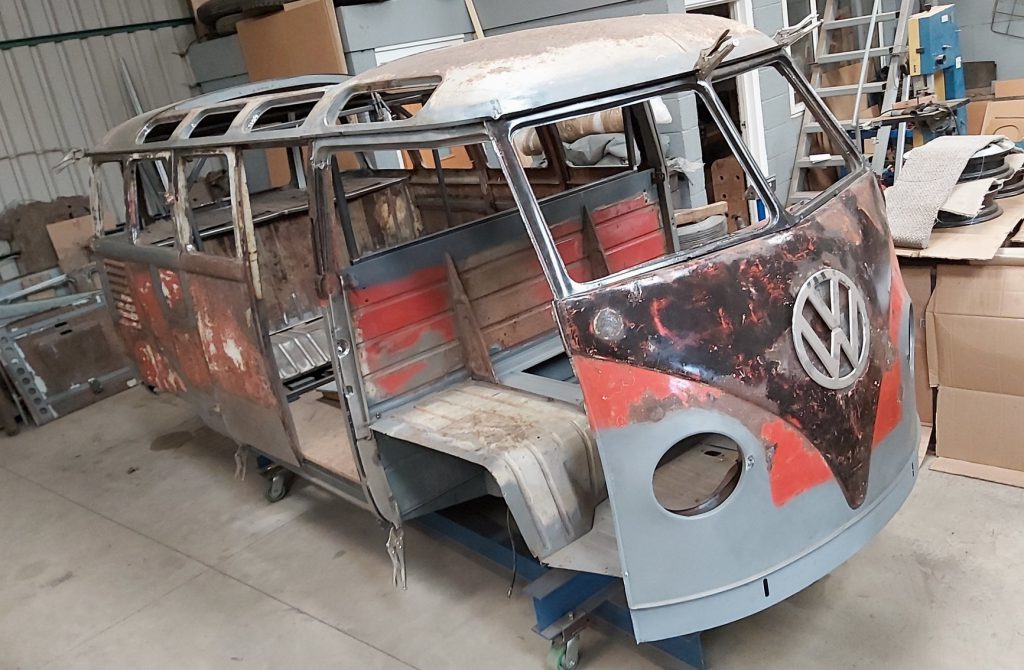
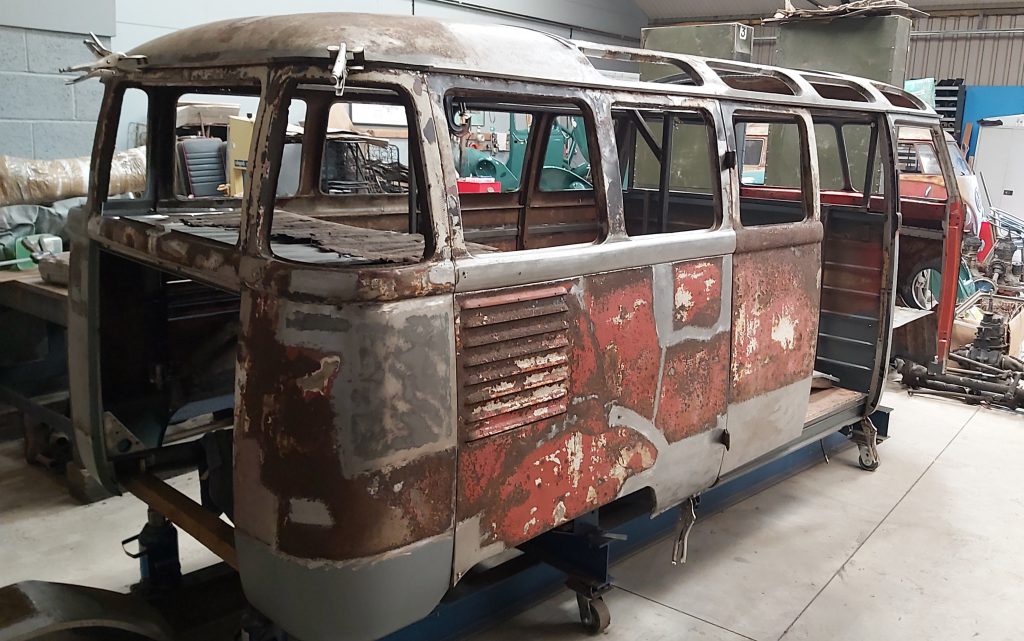
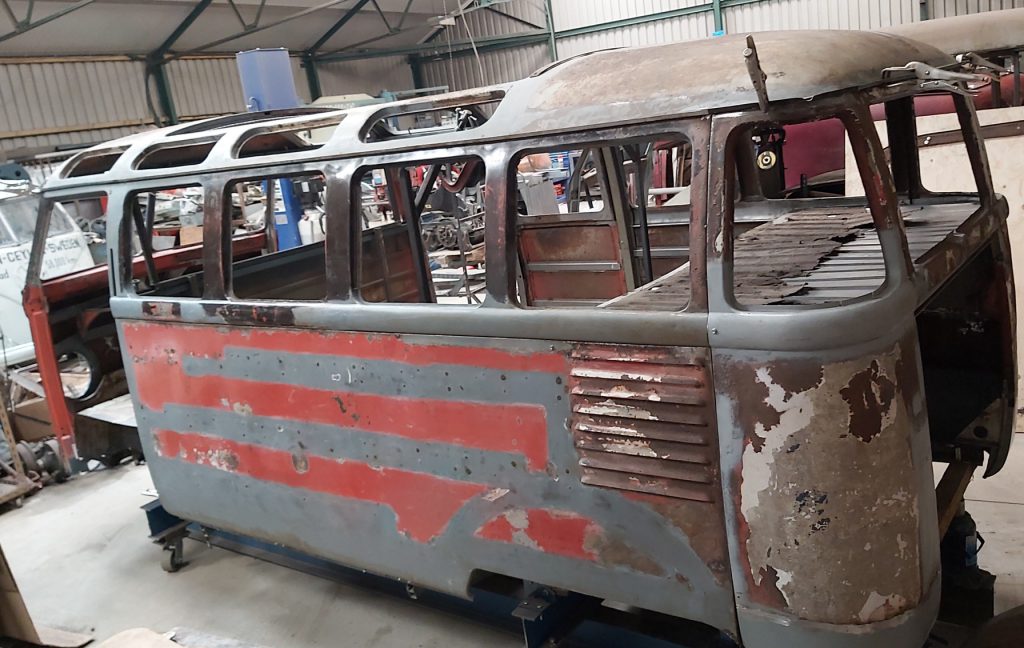
Sure, there is still a lot of work ahead, but wouldn´t you agree that this race is more than half the way done? Mark’s point of view is: “The only panels not started now are the forward cargo door and the rear horizontal shelf which you can see i have laid the original over the temporary one in the pics. It’s a big job to save that panel so I have put it off for now. So yes still plenty to do but it’s now becoming a welded together , dimensionally correct bus!”
It´s actually more than that. Here in Bonn, I am working on some components of the project, too. A very picky semaphore restoration job (a special post about this is in the works, but needs a little more investigation in some history topics), the restoring of the sliding roof mechanism, the repair of the wiper motor, the manufacturing of some door related rubbers, the restoration of the taillights etc.
The Samba is on the Hessisch-Oldendorf list for 2022 and I really want it to drive there on its own wheels! Sure, it won´t be finished by then, but the goal of riding it on the Autobahn from Bonn to Hessisch-Oldendorf is set. What do you think? Will we make it?
Have a good start into your week!
Florian
PS: for those of you who are interested in my other passion (poetry performing), here is my new livestream. Go for a two hour lesson in German language with Uncle Florian, there is even a little Volkswagen content…. 🙂
Hits: 0
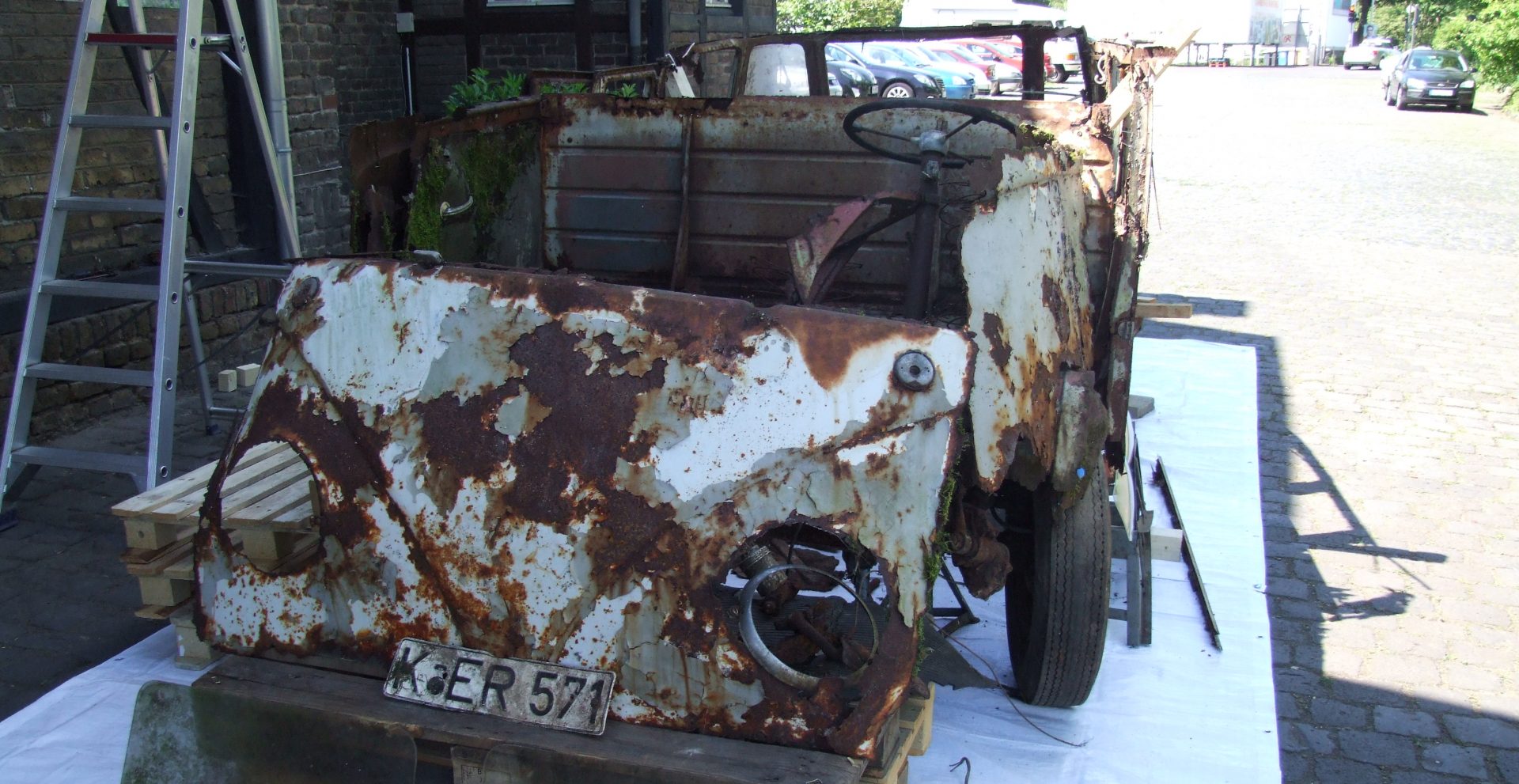
6 thoughts on ““Jetzt wächst zusammen, was zusammengehört.””
I’ve been following this story from the beginning and always look forward to another update. I’m really impressed with your devotion to this project. I no longer have a Type II but do have a 67 Bug that I’ve owned for 39 years. I sold a 67 Westphalia to buy it. Kinda regret it now. Thanks for sharing. I also enjoy your little side trips into the history of this.
Hi Steve,
a ´67 Bug is a very interesting car due to its many unique features. It´s a very good car too, the perfect daily driver for the vintage VW fan, cause it still got a lot the ‘old day´s charme’, but also a strong engine, disc brakes and the wide rear axle. Also qualitywise the ´67 was on top VW´s output, the large number of surviving ´67s proofs it. I do have one of the very first ´67s (September 1966) since I was 21 and still enjoy to ride it. By now I have tuned it with a NOS “TDE Comet” dual carb system, a set of 165 SR Michelin tires on 4,5 J type 3 wheels and a very mild lowering in the back, what provides a fantastic ride. Sure all tuning features are such who COULD have been installed already in 1967, what improoves its vintage charme.
Don´t ever regret of selling a car decades ago, but enjoy your ´67, “the last good model they produced” as Charles Bukowski stated in his novel ‘Women’ 1977. He sold his ´67 by the mid ´80s to purchase a BMW -and regret it right away….
best regards
Florian
Thank you for the update Florian! Your blog is the first thing I check every day when I get into the office. It is truly an amazing build and one that provides hope to all of us with project buses. Keep up the great work and please keep the updates coming! Cheers from Washington state USA.
Hi Mike,
you start your working day with my blog? Hope I won´t get in trouble with your boss… 🙂
Good luck with your project! Hopefully we all can meet again soon to check out all the projects finsihed during the Covid disaster!
Florian
That is really incredible! I remember when I saw it on Ben Pon 2018 and thought for myself; “that is maybe restorable, but it won´t be any original metal left”. When I now look at the pictures, then I understand how wrong I was then! The progress you and and Mark is doing is some of the best metal work I have ever seen. Interesting reading with all nerdy facts too. Looking forward to see the final result!
Thank you very much for the kind comment! 🙂